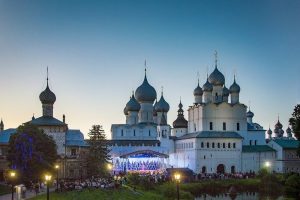
Rostov Kremlin is originally the residence of the Bishop of the Rostov Diocese, called the Metropolitan Court. Located in the center of Rostov near Lake Nero, it is now an object of cultural heritage of Russia. Today, the Kremlin ensemble consists of a bishop’s court adjoining it from the north of Cathedral Square with the Assumption Cathedral and from the south – the Metropolitan Garden. Other than these buildings, there are a lot more interesting things around Rostov Kremlin you can visit and see.
The History of the Kremlin
The Rostov Kremlin was built in the 1650s-1680s, according to a single plan of the customer – Bishop Iona Sysoevich. This plan involved the creation of a “paradise” in full accordance with the biblical description: a garden of paradise surrounded by walls with towers with a pond mirror in the center.
After the decision was made in 1787 to transfer the bishop’s chair from Rostov to Yaroslavl, the Rostov Bishop’s Court lost its function, was left unattended and gradually dilapidated. The ensemble buildings were occupied by various departments for warehouses. Divine services were not conducted in the temples of the ensemble, and the bishops were ready to sell it for scrap. However, thanks to the enlightened Rostov merchants in the 1860s-1880s, the architectural complex was restored at his expense.
Many monuments of the ensemble were damaged as a result of the tornado on August 23, 1953. Disaster recovery work of individual objects of the Rostov Kremlin grew into a scientific restoration to recreate the original appearance of the entire ensemble. The work was directed by the outstanding restorer V. S. Banige, who arrived in Rostov almost immediately after the tornado. In 1957, restoration work was completed on most of the sites. Due to lack of funding, the restoration was completed later.
In 2010, the public organization, The Fund named after St. Gregory the Theologian, with the support of Patriarch Kirill, sought to transfer the Rostov Kremlin complex to the Russian Orthodox Church. In October 2010, the governor of the Yaroslavl region, C.A. Vahrukov, made a statement on the transfer of the museum-reserve “Rostov Kremlin” church, with eviction of museum collections in the new building, and the creation of the premises of the Kremlin and the bishop’s residence; “the National Center for the wedding and baptism”. This project, however, caused criticism from experts on the protection and study of objects of art, therefore the project was rejected.
In 2013, the Rostov Kremlin entered the top ten Symbols of Russia, winning the Russia-10 media competition.
The Architectural Ensemble of the Kremlin
Here are the amazing historical monuments and buildings you can see and visit while being at the cultural heritage site:
1. Assumption Cathedral
The Assumption Cathedral (built from 1508 to 1512) stands on the site of its white-stone predecessors of the 12th to 13th centuries. The cathedral is in many ways similar to the Moscow Assumption Cathedral of the same name. This is a monumental five-domed structure, made in simple and noble forms. The height of the cathedral with a cross is 60 m. The cathedral is made of bricks, and the base and strongly protruding blades are made of white stone.
Numerous decorative elements can be found here such as arcature-columnar belts, horizontal traction panels, etc. They give the appearance of the temple a special plastic expressiveness, beauty and stability until present day. In 1991, the cathedral and belfry was transferred to the Russian Orthodox Church.
2. The belfry of the Assumption Cathedral
The belfry of the Assumption Cathedral (built from 1682 to 1688) was built on the southeast of the Assumption Cathedral. It consists of two volumes and is crowned with four chapters. By order of Bishop Jonah, thirteen bells were cast. Originally, only the Polyeleiny bell (weighs 1000 pounds) and the Swan bell (500 pounds) were cast, and shortly after them – the largest Sysaya bell weighing 2000 pounds. The bells had their own keys and produced harmonious musical chimes. At the belfry, a set of 15 bells has been completely preserved.
3. Church of the Savior in the Seny
The Church of the Savior on the Seny was built in 1675. It was the home church of Bishop Jonah Sysoevich. This church is notable for the fact that its architecture uses features of the decor of the Cathedral of the Assumption of the Blessed Virgin Mary, but only in a simpler and more rigorous design.
4. Hodegetria Church
The Hodegetria Church is one of the churches on the Rostov Bishop’s Court (Kremlin). It was built in 1692-1693, a little later than other buildings of the ensemble of the Bishop’s court, under the successor of Jonah Sysoevich, Bishop Joasaph. It is a representative of the Moscow Baroque style; the last independent building of the Bishop’s Court.
5. Church of St. John the Evangelist
The Church of St. John the Evangelist was built around 1683. This gate church is one of the last temples of the time of Bishop Jonah. Researchers note that this monument of history and architecture looks more elegant than the other Kremlin churches.
The list of monuments in the Rostov Kremlin also includes the following architectures:
- Holy Gate (1754)
- Gate Church of the Resurrection (circa 1670)
- Judicial Order (1650-1660)
- Church of the Savior in the Canopy (Holy Savior) (1675)
- Church of St. Gregory the Theologian (1680s)
- Red Chamber (1670-1680)
- Chapel (17th century)
- “House in the cellars” (17th century)
- Household (17th century)
- The cook and the haste (17th century)
- Samuel corps (17th-18th centuries)
- White (Dining) Chamber (circa 1675)
- Walls and towers of the Metropolitan Garden (1680s, mid-18th century)
- Garden tent (17th century)
- Towers and walls of the Kremlin (1670s-1680s)
It is clear that there are so many interesting things around Rostov Kremlin that visiting the site would feel like a one-stop religious historical tourist attraction spot in Russia.
